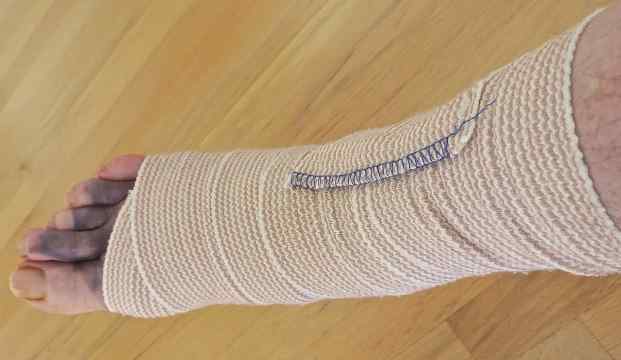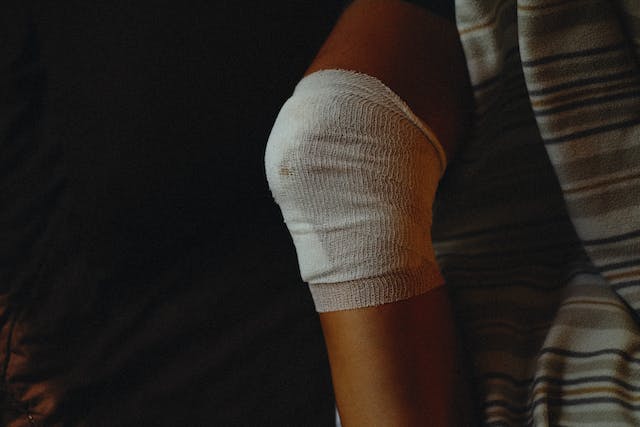How Long Can You Go Swimming After Stitches? Depends on Surgery Type
Can you swim in a chlorinated pool with stitches? Yes and no. Yes if you can take all the recommended precautions, such as covering the stitches properly, and no if you can wait. No is more recommended than yes.
You could also ask: How long can you wait to swim with stitches? This depends on the types of stitches the doctor used. You may have to wait longer before you can swim after getting absorbable stitches until the body absorbs them. If you have removable stitches, you can swim sooner, but even this differs from case to case.
What are medical stitches, and how do they work? As their name suggests, they are indeed stitches, and they are used to close a wound and promote faster healing.
They hold the edges of the wound together, allowing new skin to grow over the area. Stitches are supposed to stay in place for five to fourteen days, depending on the size and location of the wound.
Can you swim in a chlorinated pool with stitches?

Swimming is considered safe for many conditions. For instance, you can even swim while pregnant with no risk to your baby or to you.
You can swim with a yeast infection. You can also swim in the ocean with a herpes outbreak.
But when it comes to swimming in saltwater or chlorine pools with stitches, it is a different matter altogether.
That is why experts recommend you think through it carefully. Most of them recommend waiting until you are healed and the stitches are either absorbed by the body, or removed by the doctor.
If you have permanent stitches, you should not swim in any pool until the doctor has removed them. Usually, these stitches are removed in 7 to 10 days.
Even then, after the removal of the stitches, you need to wait the recommended time before you can swim. Some doctors will give you a ban of 48 hours, others longer. Frankly, the longer you can wait, the better.
If you have absorbable stitches, you will wait longer because the body takes longer to absorb them. Once absorbed, your wound will have healed enough to allow you to swim.
Swimming provides a full-body workout and as a low-impact exercise, it is recommended for all people. Thus, you do not want to miss on your sessions too much, especially if this is how you get your cardio workout.
Bottom line: swimming in chlorinated water when you have stitches is not highly recommended, but you can still do it with enough precaution. It is recommended to wait until the wound has healed considerably.
Why swimming in chlorine pools with stitches is discouraged
Chlorine is added to swimming pools for various reasons. The most common are:
- It kills harmful microbes to sterilize the water
- Chlorine shocks the pool after a heavy downpour to kill bacteria
The bacteria and other harmful organisms found in swimming pools can cause various illnesses. This is why swallowing swimming pool water is highly discouraged.
Chlorine is also a potent disinfectant, and it can irritate your skin and eyes if you are sensitive to it.
Public swimming pools have more bacteria
Overcrowded swimming pools contain more bacteria than private swimming pools. Remember, peeing in swim pools is quite common, as is the introduction of bacteria found on the skin and in human feces.
Crowded pools increase the risk of infection because they have more harmful microbes. If you have a wound that’s not healed properly, the entrance of bacteria can exacerbate the injuries.
Chlorine makes open wounds hurt. Thus, before you swim with or after stitches, make sure that the wound is completely healed and is covered with at least a healthy scab.
Poorly maintained swimming pools are dirty
Don’t swim in private swimming pools unless you are sure they are properly maintained. To prevent the thriving of microorganisms in the pool water, the right chlorine levels need to be maintained. Also, the superficial debris has to be removed consistently.
Swimming pool maintenance is hard work, and not all pool owners keep up with it properly. Before you swim in your own pool, hire someone to clean it properly.
Don’t swim if the stitches are in areas that move most
When you swim, some parts of your body move more than others. In this case, the shoulders and the knees move more than the other parts.
If that is where your stitches are, it is recommended to wait until you are completely healed. Vigorous activity that targets such parts can reopen the wound.
Don’t swim if your wound is hurting
If the wound still gives you pain, it means it is not healed properly. If there is pain, the chances of the wound reopening are high, and this would cause you to undergo another surgery.
Some wounds are also more delicate than others. For instance, swimming after a cesarean section is recommended after the wound is completely healed.
Swimming with stitches in a chlorinated pool: vital tips

If you must swim with stitches, well, swimming in a chlorinated pool is generally safe. It is just not recommended, which means if you like, you can swim.
Unless it comes into contact with an open wound, where it would then cause irritation, chlorine does not damage the stitches or the wound. Thus, to some extent, it’s safe to swim with stitches in a chlorinated pool.
If you can cover the wound properly, you can swim. Keep reading to see the recommendation for swimming with stitches.
Cover the wound with a waterproof bandage
You need to keep your wound clean and dry. Before you go to the pool, make sure your wound is fully covered with a waterproof bandage.
The bandage should be large enough to cover the entire wound and stick firmly to your skin. If you are not sure which bandage to use, talk to a pharmacist.
Get a high-quality waterproof bandage to lower the risk of any water getting inside. This is not the time to take chances with untested bandages.
You can also have someone help apply the bandage to make sure it covers the wound and the area immediately around it.
Remove the bandage immediately after swimming
After you finish swimming, remove your bandage and clean your wound thoroughly with water. You can use a piece of cotton wool soaked in water and mild soap, and then pat the place dry with a clean towel.
Avoid rubbing the area too firmly, and don’t use any harsh chemicals. They will irritate the wound and slow down the healing process.
Follow your wound care procedure
If the doctor gave you antibiotics to take, ointments to apply, and other medication, please take it as advised. It is going to make your wound heal faster.
For serious surgeries such as hip replacement, cataracts, appendicitis, and heart bypass, doctors recommend longer waiting times, sometimes stretching into three or more months before you can swim. Follow these instructions.
Can you swim with stitches after 7 days?
Even though some people seem to heal faster than others, it is not recommended to swim with stitches after 7 days.
Removable stitches and staples can be removed in 4 to 14 days. It really depends on many things, but that is the consensus.
While you might be advised to swim in 7 days after getting the surgery, submerging the incision in chlorine so soon is not advisable.
Wait for a full 14 days after the surgery to swim. If you have absorbable stitches, you might have to wait longer than 14 days.
Wrapping up
The information out there regarding swimming with stitches or not can be a bit conflicting. But the general guidelines are as follows:
- You can swim with the stitches if the wound does not hurt at all
- Your doctor has told you it is okay to swim
- The absorbable stitches have been completely absorbed
The key thing here is to know how your body heals. Some people heal faster, so even the absorbable stitches are gone in a few weeks.
It is also very important to follow the instructions your doctor gave you. If they said to keep from engaging in vigorous activity, please don’t engage in it.
Besides, they are only a phone call away, so if you are entirely not sure about anything, call them.
To conclude, is it just best to wait until your stitches have healed completely? The answer is yes. But if you just can’t wait, please follow the tips for swimming with stitches that we have shared here.
